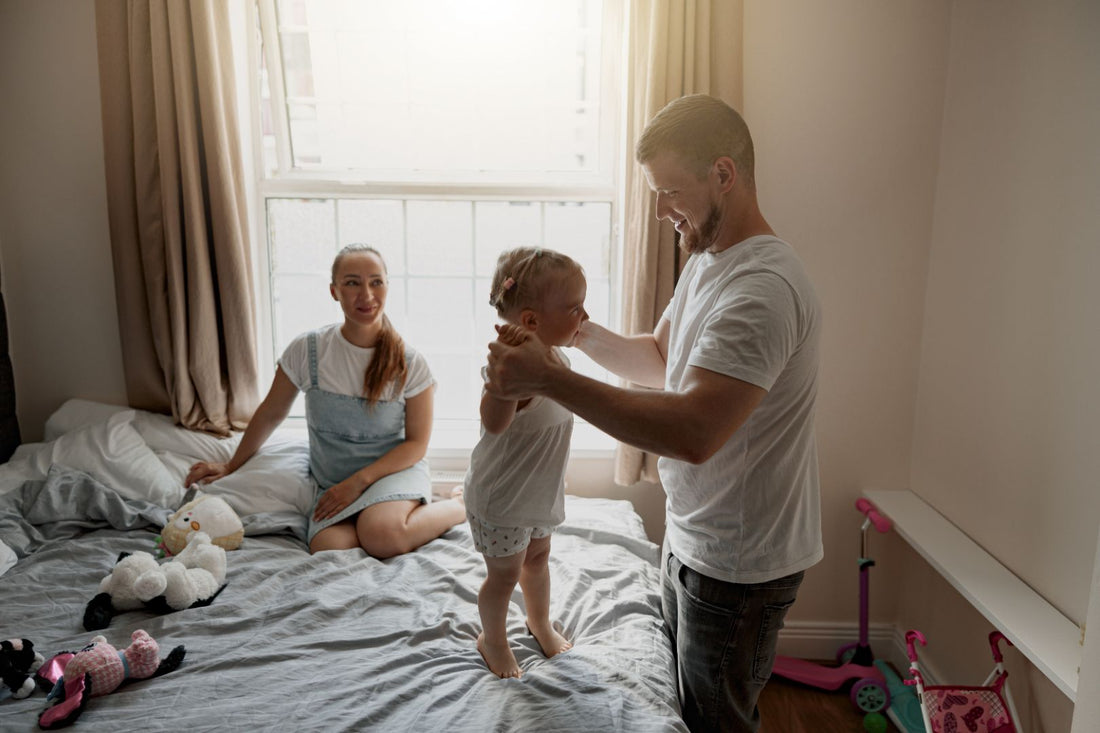Midnight sheet changes and morning cleanup routines feel frustrating when your child struggles with bedwetting. Many parents don't realize that constipation might be the hidden culprit behind those wet sheets.
Medical research paints a clear picture: children who wet their beds face double the risk of constipation compared to their peers. Studies reveal that 7.1% of children with nighttime wetting (nocturnal enuresis) receive constipation diagnoses, while only 3.9% of children without bedwetting face similar challenges.
The connection runs deeper than numbers suggest. A full bowel puts direct pressure on your child's bladder, limiting its capacity to hold urine through the night. Here's the encouraging news for parents: treating constipation brings remarkable results. Clinical studies show that 83% of children experience dry nights within three months once their constipation improves.
Your family doesn't need to face these challenges alone. This guide walks you through the surprising relationship between these conditions, helps you spot subtle signs of constipation, and provides practical solutions to tackle both issues. From understanding the underlying causes to implementing effective nighttime strategies, you'll find the answers you need to help your child succeed.
Understanding the Constipation-Bedwetting Connection
Your child's bladder and bowel share a closer relationship than you might expect. Picture this: inside your child's pelvis, the rectum nestles right behind the bladder in a snug space. This close proximity creates a direct physical connection that affects your child's nighttime dryness.
How Constipation Physically Affects the Bladder
Think of your child's pelvis as a small room where organs need to share space. When the rectum fills with stool, it pushes against the bladder walls, much like an overstuffed closet pressing against its door. Medical studies highlight several important effects:
- Children with chronic constipation show higher amounts of leftover urine after bathroom visits
- Their upper urinary tract becomes stretched
- The constant pressure tricks the bladder into feeling full even when it isn't
The numbers tell a powerful story: Wake Forest Baptist Medical Center found that solving constipation helped 83% of children achieve dry nights within just three months. Plus, one in three children with constipation struggles with daytime accidents too.
The Shared Nerve Pathways Between Bowel and Bladder
Your child's bowel and bladder work like next-door neighbors who share the same telephone line. Both organs:
- Receive messages through identical nerve centers in the brain
- Connect through specific nerve endings in the S2 to S4 regions
- Share a control system through the pudendal nerve
When constipation disrupts these shared pathways, it muddles the signals telling your child's brain about bladder fullness.
Why Many Parents Miss This Connection
Here's something surprising: your child might have regular bowel movements yet still be constipated. A revealing study of 30 bedwetting children found hidden constipation in every single case, even though most parents reported normal bathroom habits.
The tricky part? A stretched rectum loses its ability to signal when it's time for a bowel movement. This creates a challenging cycle:
- Children feel uncomfortable
- They avoid using the bathroom
- Both stool and urine get held back
- Pelvic floor muscles become tense
- Both conditions worsen
Understanding these connections helps explain why treating constipation often solves bedwetting naturally. Rather than focusing solely on nighttime accidents, addressing both issues together gives your child the best chance for dry nights and comfortable days.
Identifying Hidden Constipation in Children
Regular bowel movements don't always tell the full story of your child's digestive health. Medical studies show that constipation affects nearly 25% of children at some point, yet many cases remain hidden behind unexpected symptoms.
Signs Beyond Infrequent Bowel Movements
While fewer than two weekly bowel movements signals constipation, your child might show these subtle warning signs:
- Sudden changes in eating habits or unusual tiredness
- Mysterious stains in underwear from leaking stool
- Peculiar movements like toe-walking or squirming
- A firm or swollen belly area
- Visible blood traces in stool or around the bottom
Watch for behavioral clues too. Your child might avoid the bathroom or frequently shift positions to hold back stool. Surprisingly, what looks like diarrhea could actually be liquid stool seeping around trapped hard stool - doctors call this "overflow constipation".
The Bristol Stool Chart: Your At-Home Detective Tool
Pediatricians recommend the Bristol Stool Chart as a reliable way to monitor your child's digestive health. The chart breaks down stool types into three main categories:
- Warning Signs (Types 1-2): Hard, separate lumps that look like nuts or sausage-shaped but lumpy
- Healthy Range (Types 3-4): Smooth, soft sausage or snake-like appearance
- Too Loose (Types 5-7): Soft blobs to entirely liquid
Nighttime Constipation and Sleep Patterns
Sleep and bowel habits share a fascinating connection. Research published in the Journal of Pediatric Gastroenterology and Nutrition reveals that children with breathing difficulties during sleep show higher constipation rates. Good sleep helps move food through the digestive system properly.
Here's something unexpected: constipated children might sleep through the night more often. While this might seem like good news, it could actually mask underlying problems. Quality sleep helps reduce stress levels, which directly affects your child's digestive health.
How Chronic Constipation Leads to Bladder Leakage
Your child's body works like a finely tuned orchestra where every instrument must play in harmony. Medical research shows how bowel and bladder functions create an intricate symphony of signals and responses.
Reduced Bladder Capacity from Rectal Pressure
Picture your child's pelvis as a small room where the bladder needs space to expand. When constipation enlarges the colon, it's like adding a large piece of furniture that crowds this space. Medical studies reveal several important effects:
- Your child's bladder can't stretch properly
- The constant squeezing creates false "full bladder" signals
- Severe cases can affect the kidneys' drainage system
Think of it like squeezing a balloon from one side - it can't hold as much air. Studies confirm this pressure dramatically changes how your child's bladder fills and feels.
Pelvic Floor Muscle Dysfunction
The pelvic floor muscles work like a hammock supporting your child's bladder and bowel. When constipation persists, these muscles become confused and tense. Medical research shows:
- The muscles controlling bowel movements become overactive
- Bathroom visits become more challenging
- The body's natural reflexes get disrupted, leading to bladder control issues
Neurological Signals That Get Crossed
Your child's bowel and bladder share a complex communication network, much like telephone lines that get tangled. Research highlights fascinating discoveries:
- Pressure in the bowel triggers unexpected bladder contractions
- Both organs use the same nerve pathways and chemical messengers
- The brain receives jumbled signals about fullness and emptying
Surprisingly, studies show these mixed signals affect 70% of children with bladder symptoms, whether or not they show obvious signs of constipation.
This intricate dance between bowel and bladder creates a cycle that's hard to break without proper treatment. Understanding these connections helps explain why treating constipation often resolves bedwetting naturally.
Effective Treatment Approaches for Both Conditions
Small changes in your daily routine can make a big difference in managing your child's bedwetting and constipation. Medical research brings encouraging news: treating constipation alone helps 83% of children achieve dry nights within three months.
Dietary Changes That Make a Difference
Your child's path to dryness starts with the right foods. Pediatricians recommend 14 to 31 grams of daily fiber. Fill your child's plate with:
- Breakfast champions: Whole grain toast, hearty oatmeal, fiber-rich cereals
- Power-packed proteins: Lentils, black beans, chickpeas
- Nature's candy: Fresh berries, crisp apples, crunchy carrots
Hydration Strategies Throughout the Day
Smart timing of drinks helps prevent nighttime accidents. Medical experts suggest consuming two-thirds of daily fluids before school ends. Evening rules that work:
- Skip the fizzy drinks and caffeine - they irritate the bladder
- Make the two-hour rule firm: No drinks right before bed
- Schedule regular potty breaks every 2-3 hours
Medical Interventions When Needed
Sometimes your child needs extra help. Your doctor might suggest:
- Desmopressin (DDAVP): Helps 40-60% of children stay dry
- Bedwetting alarms: Half of children succeed with consistent use
Creating a Supportive Bathroom Routine
Success starts with comfort and consistency. Try these parent-tested strategies:
- The double-void technique: Two bathroom visits before bed
- Child-friendly equipment: Step stools and right-sized seats make a difference
- Happy bathroom space: Bright colors and fun decorations help ease anxiety
Remember, your patience matters more than perfect solutions. Harsh words or punishment only create more stress. Celebrate small victories - even one dry night deserves a high-five! Your positive attitude helps build your child's confidence and speeds the path to success.
Conclusion
Nighttime accidents and constipation challenges feel overwhelming - every parent knows those middle-of-night sheet changes and worried morning faces. Yet medical research offers encouraging news: treating constipation helps most children achieve dry nights naturally.
Your watchful eye makes the difference. Simple signs like unusual potty habits or sudden behavior changes might signal hidden constipation. Start with gentle changes:
- Regular bathroom routines
- Fiber-rich meals
- Smart drink timing
- Positive encouragement
Medical support adds extra help when needed. Nighthawk's bedwetting solutions provide reliable tools for your family's journey toward dry nights.
Remember this: your child responds best to patience and praise. Each dry morning deserves celebration - even small steps forward build confidence. Most children outgrow these challenges naturally, leading to peaceful nights and happier mornings for your whole family.
Trust the process, stay consistent, and keep encouraging your little one. Better sleep awaits both you and your child on the other side of this journey.


